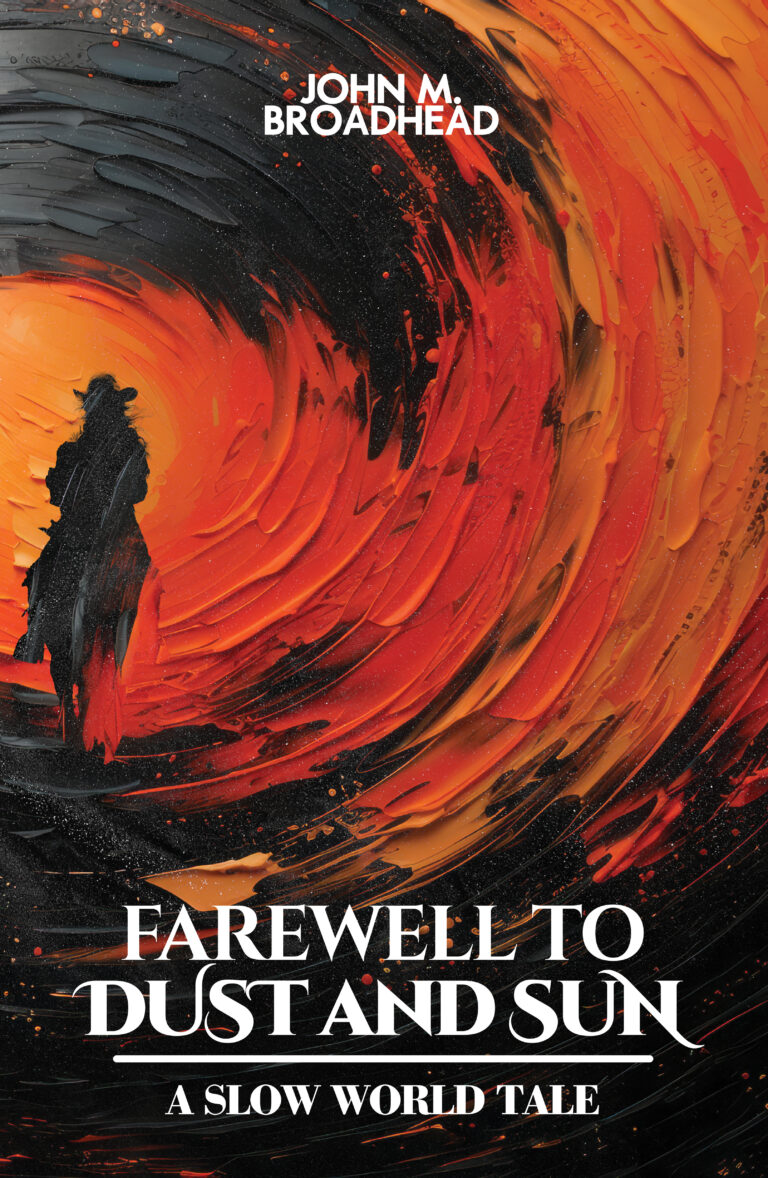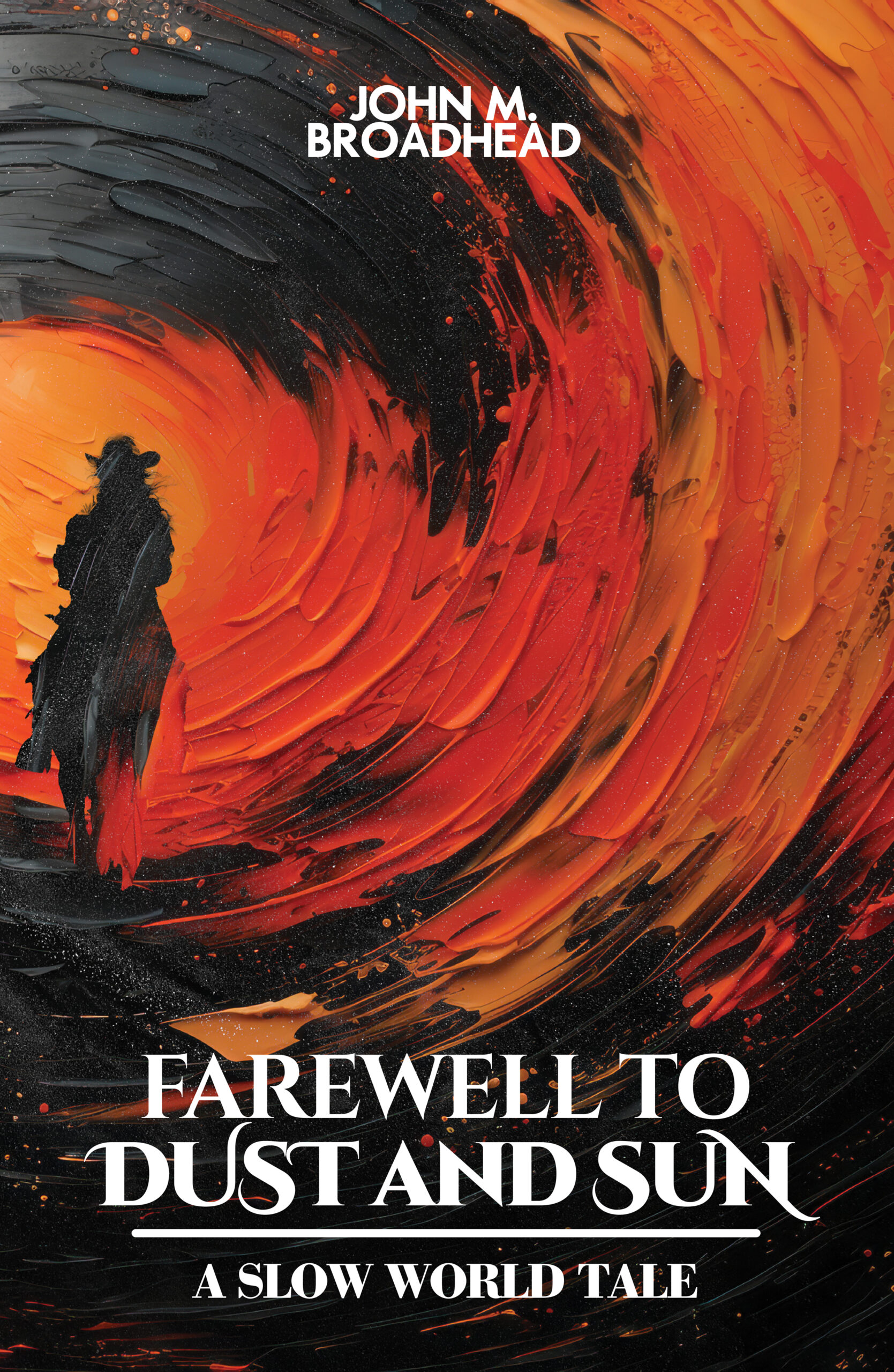FAREWELL TO DUST AND SUN, the first book in John M. Broadhead’s sweeping fantasy series, infuses elements of the western genre into a fictional post-apocalyptic setting. Dirthome shelters the desert-dwelling residents—a colony of people who toil under the dusty earth digging endless tunnels and rooms—from the same blazing sun they worship. “Our people don’t know what else to do, so we dig,” a character laments, and that’s at the core of why Coal, the novel’s protagonist, leaves Dirthome in search of answers about the wider world he lives in. Sunfall is upon the colony, and Coal is determined to find another way to save his people from the approaching Night—something his civilization hasn’t seen in generations. But the lowly shoveler realizes maybe the whole system of haves and have-nots needs to be dismantled in his ambitious pursuit for a new, better world.
Simple yet striking prose captures the imagination from the first page to the final, world-shattering sentence. The novel distills familiar dystopian themes and archetypes into something relevant and unique through a lens that’s tinged with equally familiar western aesthetics: “He saw how, every now and then, a shoveler would collapse only to be quickly rolled aside and replaced. He could imagine […] puddles that ever-so-briefly softened the hard mud before once again evaporating. The memory was so strong he could smell it.” FAREWELL TO DUST AND SUN is a heartbreaking, honest allegory of the ongoing climate crisis—and the inaction to fight it—but it also touches on issues of class division, wealth disparity, food insecurity, and worker exploitation. Early on in the colony’s plight, one of the scouts predicts a future similar to our own: “All you old farts are already gonna be dead and we younger folks are gonna have to figure it out for ourselves. Next generation can deal with its own problems, ain’t that the way it works?”
The characters are as gritty as their bleak desert setting: hard-scrabble shovelers like Coal and battle-weary scouts like old Slate, tired of a broken-down system, tired of fighting outliers who threaten the colony and its water reserves. The naming conventions alone exhibit the clever depth of the world building in Dirthome’s society: Bright, the governor’s wife and Coal’s old flame; Clay, the iron-fisted governor; and Elder Gold, the religious leader turned zealot. Coal’s desperate chase for the sun leads him beyond the only desert he’s known—to a seaside tribe and the warrior-woman Low-Mist.
The only significant disappointing aspect of the world is its reliance on stereotypes for indigenous-coded characters. While they are described as pale, their culture and traditions invoke harmful tropes of cannibalistic, savage barbarians, and they’re clearly inspired by indigenous peoples—tropes that are unfortunately still perpetuated in the genre. Despite Low-Mist being a powerful warrior—and to the book’s credit, she doesn’t let other outsiders’ selfish influence toward her people go unpunished—it’s still a jarring element that becomes central to the book’s conflict later on.
But Coal’s journey—and perhaps his lifelong, silent rebellion—puts him at odds with the colony’s tightly-held beliefs, turning friends into enemies. Prickly, headstrong Bright is a formidable presence in his life, as is the wise yet sardonic Slate. The narrative shifts from the present to the past and back, fleshing out Coal’s tale while planting the seeds of dissent. He’s a complicated protagonist who is at turns selfish and foolish, clumsy and indecisive, likable and unlikeable. The pacing is taut, even though the book fills up a large page count. Author Broadhead makes those pages matter, ratcheting up Coal’s internal and external woes, digging him deeper into each conflict like the endless, winding tunnels at the book’s heart. The character arcs are brutally sincere; even some of the minor characters show surprising growth, both good and bad and everywhere in between, as the book closes in on its cataclysmic final chapters.
John M. Broadhead’s FAREWELL TO DUST AND SUN infuses elements of the western genre into a fictional post-apocalyptic setting. A heartbreaking, honest allegory of the ongoing climate crisis, the book’s bleak setting and gritty characters paint a brutal picture with captivating relevancy.
~Jessica Thomas for IndieReader.


